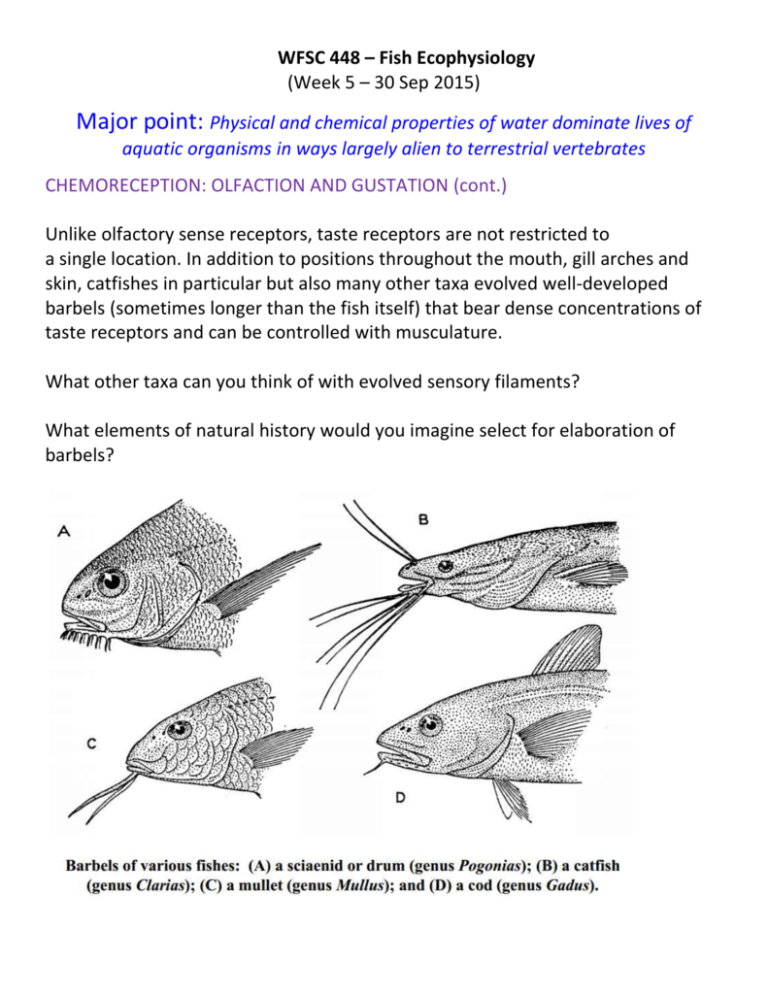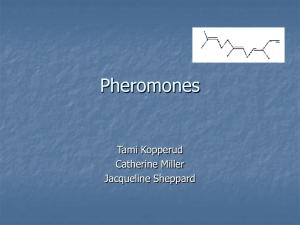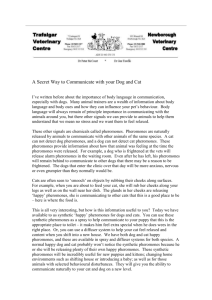Sensory biology 2. Acoustic and pressure wave detection
advertisement

WFSC 448 – Fish Ecophysiology (Week 5 – 30 Sep 2015) Major point: Physical and chemical properties of water dominate lives of aquatic organisms in ways largely alien to terrestrial vertebrates CHEMORECEPTION: OLFACTION AND GUSTATION (cont.) Unlike olfactory sense receptors, taste receptors are not restricted to a single location. In addition to positions throughout the mouth, gill arches and skin, catfishes in particular but also many other taxa evolved well-developed barbels (sometimes longer than the fish itself) that bear dense concentrations of taste receptors and can be controlled with musculature. What other taxa can you think of with evolved sensory filaments? What elements of natural history would you imagine select for elaboration of barbels? What’s up with anabantids? (gouramis, Siamese fighting fish) The rest of you figure out what these fish are doing with the extended pelvic fins Ecology of chemoreception 1: Parents smell their eggs The fish displayed parental behavior typical of the species even though no young were visually present. The response lasted the full three weeks, typical of the period of their parental behavior. When late stage embryos were replaced with newly hatched fry in the experimental chambers, the female parent switched her behavior to that appropriate for newly hatched young, continually fanning the pot and the imaginary embryos with her pectoral fins to keep oxygen levels high. 2: Homing and migration is cued by scent in salmonids Young salmon learn the scent of their natal stream before migrating to the ocean for several years, only to return to the same stream in which they were born, despite having traveled widely in the ocean. Here are electroencephalograms from salmon exposed to varied cues: 3: Goldfish cue mating behavior on an elaborate pheromone conversation Pheromones: Chemicals produced and emitted by animals and plants as messengers that affect the behavior of other individuals of the same species. (derived from Greek words pherein, to transfer and hormon, to excite) Female goldfish release two sets of pheromones: preovulatory and postovulatory Male goldfish discriminate among the steroid components of preovulatory pheromones (each steroid elicits a distinctive pattern of behavior) Postovulatory pheromones in particular elicit aggressive behavior in males Males also regulate seminal fluid and sperm production in response to stimulatory pheromones from ovulatory females, but also in response to unknown stimulatory and inhibitory cues from male competitors Females cue egg release on pheromones from males ∴ An elaborate yet invisible cascade of communication and physiological coercion is mediated by astounding sensitivity in chemoreception of pheromones. (What but design of darkness to appall?—if design govern in a thing so small. — Frost) 4: Many fish use conspecific injury cues to mediate antipredator behavior A good example of the role olfaction plays in predator avoidance is the Schreckstoff (aka alarm substance). Schreckstoff is secreted by specialized epithelial cells of various fish species. Interesting: first noted in minnows and named by Karl Von Frisch in 1938, Schreckstoff means “bad stuff”. The Wikipedia entry for Schreckstoff is excellent and should be reviewed: http://en.wikipedia.org/wiki/Schreckstoff To refine your evolutionary logic, here is a vital paragraph for consideration: “A number of different hypotheses have been proposed for the evolution of schreckstoff.[14] The first hypothesis is that the evolution of schreckstoff has been driven by kin selection. Support for this hypothesis would include evidence that individuals live in groups of closely related kin and that the release of chemical alarm signals increases the likelihood that related individuals will avoid predation. The second hypothesis, predator attraction, suggests the release of schreckstoff may attract additional predators which will interfere with the predation event, increasing the likelihood that the prey will escape and survive the attack. This hypothesis assumes predators will be attracted to schreckstoff and will interfere with one another either through competition for the captured prey or through predation of one another. It additionally assumes, despite the fact that the prey has already incurred mechanical damage, it is possible for the prey to escape and recover from the attack. Testing and validating these assumptions would provide support for the predator attraction hypothesis. The third hypothesis proposes that schreckstoff has an immune function, providing protection against pathogens, parasites and/or UVB radiation. For this hypothesis to be supported, a correlation between alarm substance cell production and the presence of pathogens and parasites would need to be observed. Direct evidence that schreckstoff inhibits the growth of aquatic pathogens and parasites would provide additional support for the immunity hypothesis. Another hypothesis is that schreckstoff is a breakdown product of mucus and club cells, induced by injury. Selection for the alarm response is primarily at the level of the receiver.“ 2000 disappearing snails Wisenden paper to be posted Sensory biology 2: ACOUSTIC (sound) AND PRESSURE WAVE (vibration) DETECTION Too good not to start with an illustration that no movement is silent in water—fish have highly sensitive senses regarding slight vibrations in water: https://www.youtube.com/watch?v=Q13VQa2Q_KA Many aspects of life—prey or food location, predator detection, species and mating cue assessment, communication, etc., depend on acoustic and pressure wave detection. Stim Wilcox deciphered the pressure wave signaling system of water striders: Stim suspended a broad tank of water by elastic cords from the ceiling, to isolate the water from building vibrations, installed a high density pipe in the center of the tank with a magnet floading on the meniscus. He also surrounded the tank with wire coils and attached an electronic bridge to the wires. He could use this device to record pressure waves. How? Energy traveling through matter is shifted when alternative densities are encountered. Ruminate on this… as light passes through glass (e.g. a prism) or pressure waves pass through a fishes body. Herring farts http://news.nationalgeographic.com/news/2003/11/1110_031110_herringfarts_2.html https://www.youtube.com/watch?feature=player_embedded&v=OcwCYIfm6eA











